
Big-Eared Cats : A Guide to Distinctive Feline Features
Cats with large ears have a charm that not only resonates with feline enthusiasts but also speaks to the primal ancestry of these domestic pets. The oversized ears on certain cat breeds are not just a distinctive aesthetic trait; they also serve practical functions. They can improve a cat’s hearing abilities, allowing them to detect even the most subtle sounds—a necessity for survival in the wild. Moreover, such features are often accompanied by sleek bodies, angular faces, and sometimes even unusual coat patterns or textures, reflecting the breed’s unique evolutionary path.
Many cat breeds that boast big ears have their origins in wild cats, maintaining that connection with their larger-eared ancestors. These physical traits have been preserved and accentuated through selective breeding, manifesting in both the physical appearance and sometimes the behavior of domesticated breeds. Breeds with large ears often have playful, attentive, and active dispositions. From the energy of the Abyssinian to the distinctive baldness of the Sphynx, the variety in these cats is as vast as their popularity. Recognizing and understanding this diversity is crucial for potential pet owners, as is a familiarity with the responsibilities of ethical breeding and conservation efforts to ensure the health and welfare of these breeds.
Key Takeaways
- Large-eared cat breeds exhibit an array of functional and aesthetic traits that trace back to wild ancestors.
- Selective breeding has preserved and emphasized the oversized ear trait, alongside diverse personalities and care needs.
- Ethical breeding practices and informed guardianship are essential for the wellbeing and future of big-eared cat breeds.
Origins of Big-Eared Cat Breeds
The development of cat breeds with notably large ears stems from both ancient lineage and human-driven breeding practices, highlighting certain genetic traits like those seen in the Abyssinian and Siamese cats.
Historical Significance
Historically, the Abyssinian cat, with its large, alert ears, is believed to resemble the African wildcat, Felis lybica. It is one of the oldest cat breeds, and its origins are often linked to Ethiopia, formerly known as Abyssinia. Meanwhile, the Siamese cat hails from Thailand and is recognized for its distinctive large ears and striking blue eyes. Both breeds have a storied past, intertwining with human civilizations and culture, magnifying features advantageous for their environments, such as large ears for better heat dissipation and keen hearing.
Genetic Mutation and Selective Breeding
Genetic mutations can naturally occur, leading to variations in physical traits like ear size. For instance, the Siamese cat’s large ears might have initially appeared as a natural mutation but were perpetuated through selective breeding. Breeders have, over time, chosen cats with desirable traits to produce offspring reflecting those characteristics. This process, paired with natural mutations within feline populations, has resulted in the distinctive big-eared breeds admired today.
Selective breeding has been pivotal in emphasizing traits such as the bat-like ears of the Cornish Rex, which originated from a genetic mutation in Cornwall, England. The resulting diversity in ear size and shape across various breeds showcases the blend of wildcat genetics and human influence on breed development.
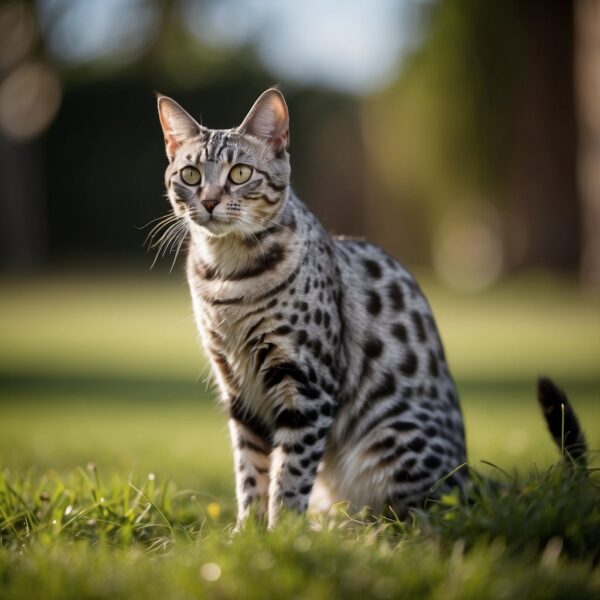
Characteristics of Cats With Large Ears
Cats with oversized ears possess distinct physical characteristics and diverse personality traits that are captivating to feline enthusiasts.
Physical Attributes
Cats graced with large ears usually have prominent, pointed ears that stand erect, enhancing their keen sense of hearing. The Siamese and Oriental Shorthair, for instance, are breeds recognized for their big ears paired with a triangular-shaped head and a sleek, slender body. These oversized ears can give them a unique appearance, sometimes resembling the alertness and wild aspect of their larger feline kin. The Abyssinian, a breed often noted for its large, well-cupped ears that are set forward on the head, also boasts a muscular build, and its almond-shaped eyes add to its intelligence-filled expression.
Personality Traits
When it comes to demeanor, cats with large ears are often described as intelligent cats; their heightened sense of hearing may contribute to their alert and perceptive nature. They can be social and affectionate, thriving in interactive environments where they can engage with guardians and other pets. Many of these cats, such as the Siamese and the Oriental breeds, are known for being playful cats, displaying an athletic vigor that can be attributed to their inquisitive and playful personality. The temperament of these breeds is often a blend of curiosity and intelligence, making them engaging companions who are quick to learn and participate actively in their homes.
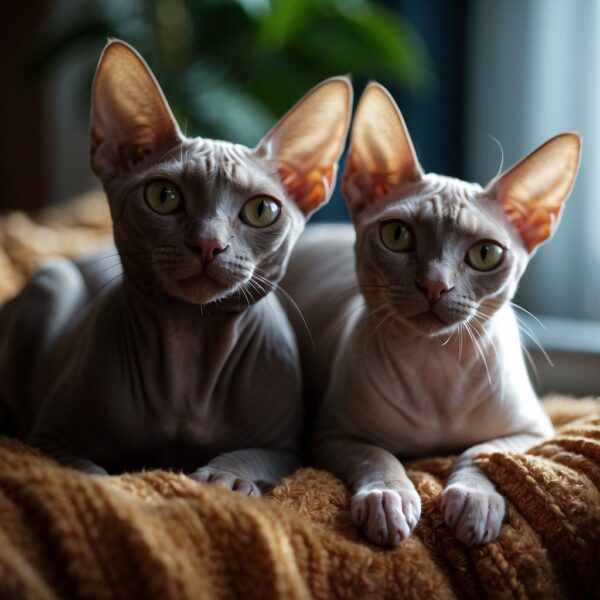
Specific Big-Eared Breeds
Cat breeds with big ears are not only unique in appearance but often possess energetic and intelligent personalities. The following subsections will introduce popular big-eared breeds as well as rarer, exotic varieties that cat enthusiasts adore.
Popular Big-Eared Breeds
Abyssinian
The Abyssinian cat, with a lifespan of 10-15 years, is known for its large, alert ears and resembles the African wildcat. These cats come in colors such as red, ruddy, fawn, and blue.
Siamese
Siamese Cats, easily identifiable by their striking blue eyes and large triangular ears, have a distinctive vocal personality and come from Asian origins.
Cornish Rex
The Cornish Rex, with its bat-like ears, enjoys an active and outgoing nature. This breed’s coat mutation leads to a distinctive wavy fur, originating from Cornwall, England.
Sphynx
Characterized by their hairless appearance and large ears, Sphynx Cats have a friendly and energetic demeanor. Despite the lack of fur, they still require regular skin care.
Oriental Shorthair
The Oriental Shorthair, sporting large pointy ears, boasts an extensive color palette and is closely related to the Siamese, sharing the same slender body type.
Balinese
A longer-haired cousin of the Siamese, the Balinese Cat is notable for large ears and a silky coat, matched with an engaging and social personality.
Rare and Exotic Varieties
Chausie
The Chausie is a hybrid of the Abyssinian and wild Jungle Cats, featuring a striking appearance with big, tufted ears. They retain a high activity level and need ample space to thrive.
Savannah
Savannah Cats, a cross between domestic cats and the wild African serval, boast large, pointed ears atop a tall, slender frame. These cats are known for their high energy and playful nature.
Egyptian Mau
The Egyptian Mau carries a spotted coat and large, almond-shaped ears. It’s one of the few naturally spotted breeds of domestic cat and is famous for its agility.
Peterbald
The Peterbald features a unique slender body and large ears as well. Known for their hair-losing gene, they share this trait with the Sphynx but often have a fine down on their skin.
Singapura
One of the smallest breeds, the Singapura Cats showcase big, expressive ears. They have a ticked coat pattern and a captivating, playful disposition.
Ocicat
The Ocicat displays large, tufted ears and spots resembling a wild cat but is entirely domestic. Their adventurous spirit is matched by a sociable and affectionate nature.
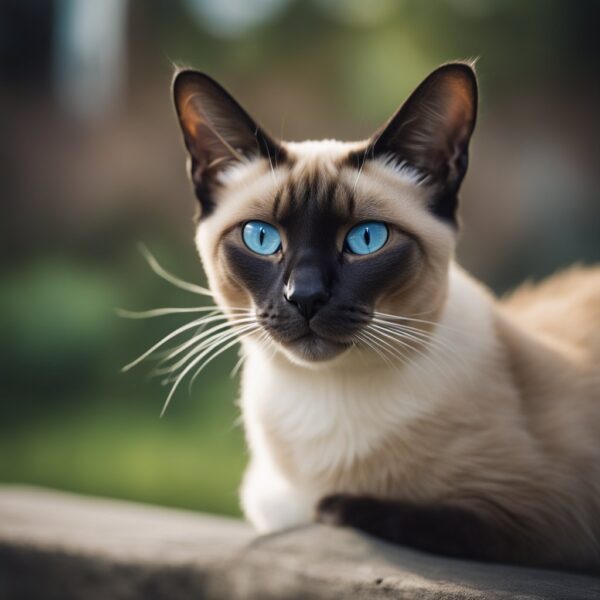
The Role of Big-Eared Cats in Culture
Big-eared cats hold a distinctive place in various cultures, often admired for their exotic and unique appearance which closely resembles their wild ancestors.
Symbolism and Representation
Big-eared cats, with their ticked and spotted coats, have been a symbol of mystique and allure across numerous cultures. The Siamese cat, for instance, with its large, angular ears and striking blue eyes, has often been associated with royalty and elegance in Thai culture. Its sleek and wild look lends it an air of sophistication that has been celebrated in art and folklore.
Similarly, breeds like the Abyssinian, sporting a ticked coat, are thought to resemble the sacred cats worshiped in ancient Egyptian society. These cats were valued not just for their hunting prowess but also for their regal bearing and were often depicted in hieroglyphs, sculptures, and paintings.
The wild appearance of big-eared cats often draws parallels with their feral counterparts. For example, the Chausie, with its strong physique and large ears, maintains the exotic and wild appearance of its jungle cat ancestors, signifying untamed nature and freedom.
Interestingly, the Cornish Rex, with its distinctively large ears and wavy coat, can be seen as a representation of human ingenuity and the love for the unique. Originating from Cornwall, England, the breed has been a testament to the fascination for novelty and diversity within domestic animals.
Choosing a Big-Eared Cat
When selecting a big-eared cat, prospective pet parents should consider how a breed’s characteristics align with their lifestyle and the unique aspects of caring for these distinctive animals.
Compatibility with Lifestyles
Big-eared cat breeds often possess a dynamic combination of traits that may make them suitable for various types of families and individuals. Breeds like the active and energetic Abyssinian thrive in environments where they can play and explore, making them ideal for families with interactive lifestyles. On the other hand, breeds such as the Siamese, with their affectionate nature and blue eyes, often seek constant companionship and can be a match for individuals seeking a committed cat relationship. When choosing a big-eared breed, one should assess the activity level and sociability of the cat against their own daily routines and household dynamics.
Considerations for Lifestyle Compatibility:
- Activity Level: Energetic vs. Calm
- Sociability: Interactive vs. Independent
- Space Requirements: Ample Space vs. Small Living Conditions
Pros and Cons of Big-Eared Breeds
Pros:
- Many big-eared breeds are intelligent and can be easily trained for various activities and commands.
- Typically muscular and long-tailed, these cats often have striking appearances and can be quite agile.
- Most of these breeds are family pets by nature, capable of forming strong bonds with their owners.
Cons:
- Such breeds may require more engagement and activities to satisfy their high energy levels.
- Grooming can be a necessary commitment, especially for breeds with unique coats.
- Due to their exotic lineage, some big-eared cat breeds can be quite expensive to adopt and care for.
While slender legs and large ears make for an elegant physique, such features can also imply a need for safe spaces to climb and explore. On the balance, these cats can make delightful companions, but they do require a dedicated parent prepared to meet their needs.
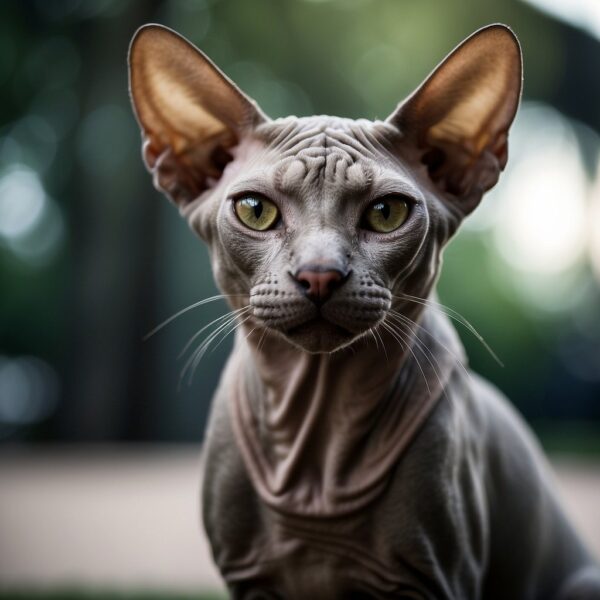
Conservation and Ethical Breeding
In the world of big-eared cat breeds, it is imperative to focus on the preservation of the breeds’ unique characteristics and to encourage ethical breeding practices that protect the well-being of the cats.
Preservation of Breeds
Preservation of cat breeds, particularly those with big ears, involves meticulous documentation and monitoring to ensure genetic diversity and health. Conservation efforts for breeds like the wild-looking Chausie, which is a crossbreed between an Abyssinian and jungle cats, aim to maintain their distinctive features while preventing health problems. Breeders must work to preserve the phenotype and genotype of such breeds, including smaller breeds and hairless breeds, which often face unique challenges due to their specific traits.
- Documenting Pedigrees: Accurate records of lineage and genetic markers.
- Health Screenings: Regular health checks to identify and curb hereditary diseases.
- Genetic Diversity: Avoiding inbreeding by introducing unrelated genetic lines.
Ethical Breeding Practices
Ethical breeding requires an understanding of genetics, health, and the welfare of the cats. Breeders must choose not to merely accentuate physical traits like big ears but also to prioritize the animals’ health.
- Selective Breeding: Carefully selecting breeding pairs to enhance health and temperamental suitability for domesticity, not just distinctive features such as large ears.
- Health and Welfare Standards: Ensuring living conditions that allow for physical and psychological well-being.
- Opposition to Exploitation: Breeders must avoid overbreeding and ensure that they do not exploit the uniqueness of certain traits at the expense of the cats’ health, such as with hairless breeds where skin care is paramount.
Cat Breed Associations and Standards
Cat breed associations play a crucial role in the recognition and standardization of feline breeds, including those with distinctive large ears. They are responsible for setting the breed standards that describe the ideal characteristics of each breed, which are used to guide breeding programs and judge cat shows.
Breed Recognition
Cat breed associations are tasked with the formal acknowledgment of cat breeds. To achieve recognition, breeds must meet specific criteria that typically include breed history, health standards, and physical characteristics. For instance, Balinese cats, known for their long-haired, silky coats, and colorpoint longhair features, must be consistent in these traits across multiple generations to gain recognition.
- The International Cat Association (TICA) and the Cat Fanciers’ Association (CFA) are two prominent organizations that recognize different breeds, including those with large ears.
- Breeds like the Siamese and Balinese, celebrated for their affectionate and social nature, are often recognized by both associations for their distinct ear shape.
Show Standards
Show standards are meticulously detailed by associations and entail the characteristics that cats are judged on in competitive shows.
- Characteristics often include ear size and shape, body type, behavior, coat color, and texture.
- Athletic breeds such as the Abyssinian are favored for their muscular build and alertness, which is complemented by large, pointed ears.
The table below summarizes key standards for breeds with large ears:
| Breed | Association | Key Traits |
|---|---|---|
| Siamese | TICA, CFA | Intelligent, athletic, large ears |
| Balinese | TICA, CFA | Affectionate, social, long-haired |
| Abyssinian | TICA, CFA | Athletic, intelligent, short coat |
| Oriental Shorthair | TICA, CFA | Social, slender build, large ears |
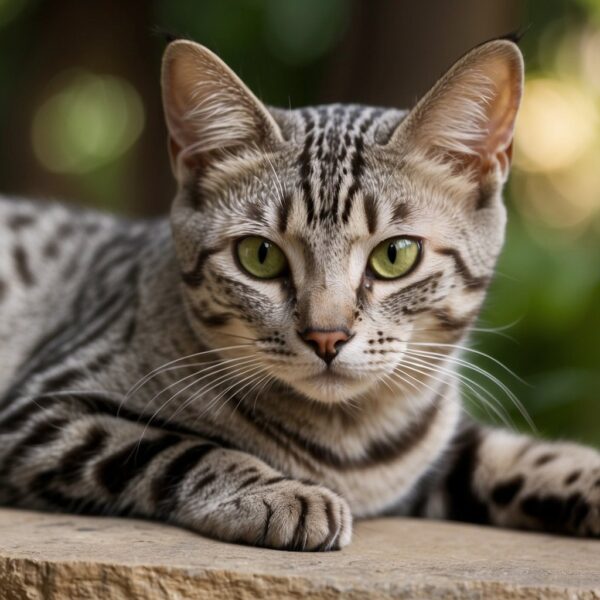
Frequently Asked Questions
The following questions address common curiosities regarding domestic cat breeds that possess particularly large ears, their identification, genetic backgrounds, and distinctive coat patterns.
What are some domestic cat breeds known for having particularly large ears?
Some well-known domestic cat breeds with large ears include the Siamese, Oriental Shorthair, and the Savannah. The Siamese, an Asian breed, is recognized for its striking ears, while the Oriental Shorthair exhibits a similar ear size due to its genetic ties to the Siamese. The Savannah, a cross between domestic cats and the serval, also features notably large ears.
How do I identify a cat breed based on its ear size and shape?
Identifying a cat breed by its ear size and shape involves observing the ear’s length, width, placement on the head, and whether they stand erect or fold over. Cat breeds like the Abyssinian and the Oriental have large, pointed ears that sit wide at the base and taper to rounded tips, while the Scottish Fold’s ears are known for their unique fold.
Why do some cat breeds have notably larger ears than others?
Some cat breeds have larger ears due to selective breeding and genetic factors, with the trait often enhancing their auditory capability. Larger ears can help in tracking prey and are a distinctive feature in breeds that have wild ancestors or were bred for a particular appearance, such as the Savannah and the Caracal.
Are there specific cat breeds with large ears that also exhibit spotted or wild-like coat patterns?
Yes, specific cat breeds with large ears and wild-like coat patterns include the Bengal, Ocicat, and the aforementioned Savannah. The Bengal resembles a miniature leopard with its spotted coat and large ears, while the Ocicat sports a wild appearance and the Savannah carries the legacy of its serval ancestry.
Which small cat breeds are characterized by their oversized ears?
The Sphynx, known for its hairless appearance and triangular face, is a small breed with oversized ears. The Cornish Rex and Devon Rex, both small breeds with distinct curly coats, also have large ears that stand out against their petite frames.
What characteristics define a tabby cat with unusually large ears?
A tabby cat with unusually large ears typically possesses a striped or dotted pattern in their fur, known as the “classic” or “mackerel” tabby pattern. These large ears are often wide at the base with a pointed tip, and several domestic breeds, including the aforementioned Oriental Shorthair and Savannah, may have them.